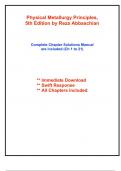Exam (elaborations)
Solutions for Physical Metallurgy Principles, 5th Edition by Abbaschian (All Chapters included)
- Course
- Institution
Complete Solutions Manual for Physical Metallurgy Principles, 5th Edition by Reza Abbaschian, Lara Abbaschian ; ISBN13: 9798214001661....(Full Chapters included and organized in reverse order from Chapter 21 to 1)...1. The Structure of Metals. 2. Characterization Techniques. 3. Crystal Binding. ...
[Show more]



